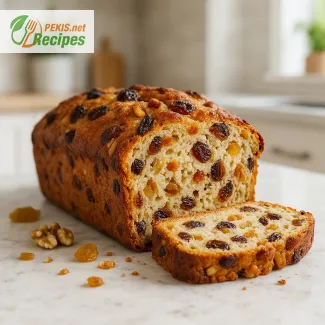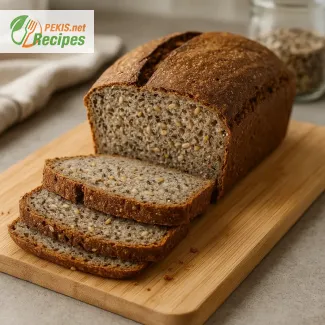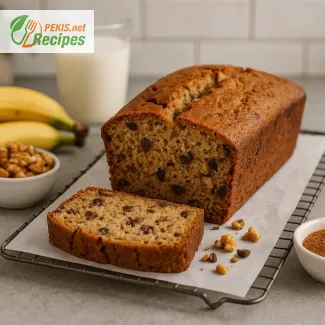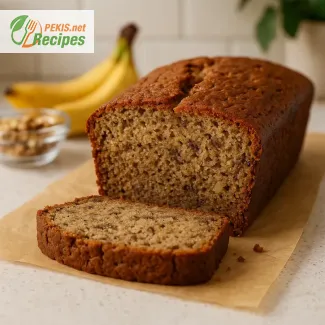A naturally risen gluten-free sourdough bread without xanthan gum that delivers a tender, springy crumb, a crisp golden crust and deep, slow-fermented flavour. Built on rice flour, buckwheat and an active gluten-free starter, it transforms simple grains into a rustic loaf with comforting aroma and old-world character.
Years of working with natural fermentation showed how much flavour and structure gluten-free dough can develop when treated with patience. Sharing one small trick here: balancing wholegrain flours with lighter starches creates a softer rise without any gums. PEKIS – professional chef and recipe developer with over 25 years of experience in cooking and baking, specialised in European and international cuisine

Naturally risen gluten-free sourdough loaf without xanthan gum
Artisan-style bread with open crumb, tangy flavour and gentle crust
Warm from the oven, the first slice of gluten-free sourdough bread cracks softly under the knife, releasing a wave of toasty aroma, gentle acidity and a hint of natural sweetness from long fermentation. The crust is thin yet crisp, the interior moist, springy and slightly elastic, with an open crumb that finally looks like the bread everyone misses after going gluten-free. Instead of relying on xanthan gum or synthetic binders, structure comes from careful fermentation, a balanced flour blend and patient handling of the dough – the same slow craft that shaped rustic loaves in traditional kitchens long before additives existed.
Gluten-free baking has often meant dense, crumbly loaves with a sandy texture and fleeting freshness. With a well-fed gluten-free sourdough starter, controlled hydration and the right combination of wholegrain and starch-based flours, it becomes possible to achieve a loaf that rises high, slices cleanly and stays pleasant for more than just a few hours. This bread stands somewhere between homely farmhouse loaf and modern artisan bakery style: chewy but not tough, soft but not cakey, with a flavour profile that develops over time instead of collapsing into blandness.
Historically, sourdough techniques evolved as a way to preserve grain, enhance digestibility and create bread in regions with different wheat varieties. Today, those same methods allow a new generation of gluten-free bakers to work with rice, buckwheat, sorghum or millet and still enjoy the complexity of slow fermentation. In many central and northern European kitchens, naturally leavened loaves are once again preferred to yeasted quick breads, and gluten-free versions are gradually claiming their place alongside traditional sourdough on the table.
What makes gluten-free sourdough bread without xanthan gum special
Removing both gluten and xanthan gum means depending entirely on:
- the stability of your starter,
- the interaction between different gluten-free flours,
- and the timing of fermentation, proofing and baking.
Instead of a sticky, gummy dough, the mixture behaves more like a thick batter that slowly traps gas bubbles as the starter works. Proper hydration lets starches swell and bind water, while finely ground wholegrain flours add aroma, colour and fibre. With correct ratios, the crumb becomes elastic enough to hold its shape, yet remains tender and easy to bite through.
For bakers who already enjoy rustic loaves, this style of bread pairs beautifully with more earthy alternatives like a buckwheat-based gluten-free loaf. There is even a dedicated Gluten-Free Rustic Buckwheat Bread Recipe for days when deeper, nuttier flavours are the goal.
Key components: starter, flours, hydration and fermentation
Gluten-free sourdough starter
A robust gluten-free sourdough starter is the heart of this recipe. Regular feeding with naturally sweet, mild flours keeps the acidity balanced and encourages lactic acid bacteria that contribute gentle tang rather than harsh sourness. A lively starter creates more oven spring, a more open crumb and a crust with even blistering.
Flour blend and starch balance
The flour mix usually combines wholegrain gluten-free flours for structure and flavour with lighter starches for softness and lift. Wholegrain components give the loaf its characteristic chew and colour, while starches help achieve a fine, airy crumb without gum-like additives. The balance between these elements defines whether the bread leans more rustic and hearty or lighter and sandwich-friendly.
Hydration, mixing and fermentation time
Higher hydration is crucial for gluten-free sourdough. Water allows starches to gel properly, supports gas retention and creates that shiny, moist crumb associated with slow-fermented loaves. Gentle mixing and short rests between folds help distribute hydration evenly without overworking the dough. Long, controlled bulk fermentation at room temperature develops flavour and aroma, while the final proof shapes the loaf’s rise and crust thickness.
Why you’ll love this gluten-free sourdough bread
- Naturally gluten-free – built on grains and starches that avoid wheat, barley and rye.
- No xanthan gum – structure comes from technique, not additives.
- Artisan texture – a crisp crust and soft, open crumb that slices cleanly.
- Deep, complex flavour – slow fermentation adds gentle tang and sweetness.
- Versatile to serve – ideal for toast, sandwiches, or alongside soups and salads.
- Satisfying to bake – a project that rewards attention to detail and craft.
Creative variations and serving ideas
- Seeded crust – press a mix of sunflower, sesame and flax seeds onto the surface for extra crunch and nutty flavour.
- Herb-infused loaf – fold in fresh rosemary, thyme or chives for an aromatic bread that pairs with roasted vegetables or grilled fish.
- Olive and garlic version – add finely chopped olives and roasted garlic for a Mediterranean-style loaf.
- Breakfast toast loaf – slightly increase natural sweetness with a touch of honey or maple syrup for a bread that toasts beautifully with butter or nut spreads.
- Rustic country style – shape as a round boule, dust with flour and score deeply for a more traditional, farmhouse appearance.
Storage and make-ahead tips for gluten-free sourdough
Gluten-free sourdough tends to dry faster than wheat bread, so thoughtful storage keeps the crumb pleasant for longer. Once fully cooled, the loaf can be wrapped in a clean cloth and stored in a bread box for short-term use, or sliced and frozen for later.
- Room temperature – keep well wrapped for 1–2 days, then toast slices for best texture.
- Refrigeration – not ideal for long periods, as it can firm the crumb; use only if the kitchen is very warm.
- Freezer-friendly – slice, separate with parchment and store in an airtight container; reheat directly from frozen in toaster or oven.
- Make-ahead – the dough can often handle a cold overnight proof, which develops flavour and makes it easier to fit baking into a busy schedule.
- In a large bowl mix rice flour, buckwheat flour, potato starch, tapioca starch and salt until fully combined.
- Add the active gluten-free sourdough starter, warm water, olive oil and apple cider vinegar. Mix with a spatula until you get a thick, smooth batter-like dough.
- Cover the bowl and let the dough rest for 30 minutes to allow hydration.
- Wet your hands and gently fold the dough from the edges toward the centre 2–3 times to improve structure.
- Transfer the dough into a loaf tin lined with parchment paper. Smooth the surface with wet hands.
- Cover and let rise at room temperature for 3–5 hours, until the dough has visibly expanded and small bubbles appear on the surface.
- Preheat the oven to 220 °C (428 °F).
- Bake for 20 minutes, then reduce temperature to 190 °C (374 °F) and continue baking for 40 minutes.
- Remove from the tin and bake directly on the rack for an additional 10 minutes for a firmer crust.
- Cool completely on a wire rack before slicing to maintain structure.
FAQ questionWhy does gluten-free sourdough bread need more hydration?
Gluten-free flours and starches absorb water differently from wheat, so the dough needs higher hydration to become cohesive and elastic enough to trap gas. A thicker, batter-like consistency lets starches swell and gel, which creates structure in place of gluten. This extra water also helps achieve a moist, springy crumb instead of a dry, crumbly texture and keeps the bread pleasant for longer after baking.
FAQ questionHow can the bread hold together without xanthan gum?
Instead of xanthan gum, structure comes from a combination of balanced flour blend, proper hydration and slow fermentation. Wholegrain flours like buckwheat add natural stickiness and body, starches provide lightness and lift, and the active sourdough starter builds a network of tiny gas pockets. Gentle folding and long resting times help this network stabilise, so the loaf can rise well and slice cleanly without artificial binders.
FAQ questionWhy use a gluten-free sourdough starter instead of yeast?
A gluten-free sourdough starter brings deeper flavour, better keeping quality and a more complex texture than simple yeast. The mix of wild yeasts and lactic acid bacteria creates a tangy, aromatic crumb and a crust that colours beautifully. Fermentation also allows the dough to develop structure gradually, which is crucial when baking without gluten or xanthan gum, and can make the bread feel more satisfying and less “starchy” on the palate.
FAQ questionHow long should gluten-free sourdough dough proof?
Proofing time depends on the activity of the starter, room temperature and hydration, but gluten-free sourdough often needs 3–5 hours at room temperature for a good rise. The dough should look visibly puffed, with small bubbles on the surface, rather than doubled in size. Over-proofing can cause the loaf to collapse or crack, so watching the dough, not the clock, is key to a stable crumb and even crust.
FAQ questionHow can I keep gluten-free sourdough bread fresh for more than one day?
Once completely cooled, the loaf keeps best when wrapped well and stored at room temperature for a day or two, then sliced and frozen for longer storage. Freezing individual slices and reheating them directly in a toaster or hot oven restores a crisp crust and soft interior. Avoid long refrigeration, as it tends to make gluten-free bread firm and dry, while freezing locks in moisture and preserves the slow-fermented flavour.
FAQ questionWhat can I serve with gluten-free sourdough bread without xanthan gum?
This bread’s mild tang and rustic aroma pair beautifully with both savoury and sweet toppings. It works as a base for open-faced sandwiches with eggs, cheese or roasted vegetables, and toasts well for breakfast with butter, honey or nut spreads. The firm yet tender crumb makes it ideal alongside soups, stews and salads, where the slices can soak up sauces without falling apart, highlighting the bread’s chewy texture and golden crust.
The slow, natural rise of gluten-free sourdough creates a loaf that feels both familiar and refreshingly different. Each slice carries the balance of wholegrain depth, gentle acidity and a soft, open crumb achieved without xanthan gum. This method relies on patience, hydration and fermentation rather than additives, making the bread feel closer to traditional artisan loaves.
Every stage of the process guides the dough toward better structure — from mixing the flours to giving the starter enough time to shape flavour and texture. With careful proofing and proper baking temperature, the loaf forms a crisp crust that contrasts beautifully with its moist interior.
The flavours continue to develop after baking, allowing the bread to shine whether served with simple spreads or hearty meals. Its versatility makes it easy to enjoy throughout the week, especially when slices are frozen and refreshed in the toaster.
Choosing this approach opens the door to healthier, more natural bread-making, where technique replaces convenience ingredients. The result is a satisfying, wholesome loaf that highlights what slow fermentation can achieve in gluten-free baking.
Allergens present in the recipe:
- None: Gluten-free formulation with gluten-free starter
Tips to remove allergens and gluten:
- Substitute rice flour with certified gluten-free oat flour for a slightly sweeter flavour.
- Replace buckwheat flour with sorghum flour for milder aroma.
- Use neutral oil instead of olive oil if sensitive to olive fruit derivatives.
- Vitamin B6 (mg): 0.07 – supports metabolism
- Magnesium (mg): 38 – contributes to muscle and nerve function
- Iron (mg): 0.9 – supports oxygen transport
- Potassium (mg): 92 – important for fluid balance
- Zinc (mg): 0.5 – supports immune function
- Polyphenols (mg): 18 – contribute to cellular protection
- Flavonoids (mg): 6 – support anti-inflammatory processes
- Ferulic acid (mg): 2.5 – helps protect cells from oxidative stress





